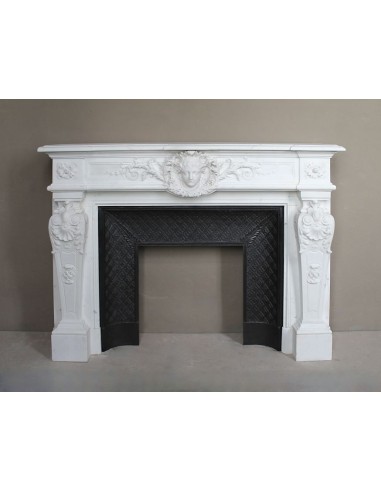MARIE ANTOINETTE OF HABSBURG LORRAINE
It is this very young queen whose face is carved in this fireplace.
It was very easy (because of her unmistakable hairstyle***) to identify these features with those of the last true queen of France, who, forced at the age of 14 into marriage with the very young French dauphin Louis XVI, was the object of all possible malice from the French people during her first period of reign (and what did you want to expect from a child torn from her homeland and forced to live among the thousands of cicisbei who frequented the palace of Versailles? ) and then redeemed herself before and during the revolution, even to the point of being guillotined at the age of 38, moreover without any evidence, by the judges of the Revolutionary Tribunal. She was the last queen of the so-called “Ancien Régime.” I must say that the French people, after her death, somehow redeemed her, in some cases, even incensed her, as in the case of the man who commissioned this fireplace. In short, somehow, a few decades after her execution, “The Austrian” (as she was called upon her arrival at Versailles) became almost a heroine. How fallacious, and mobile, are the feelings of the people!!!
Our fireplace mantel was undoubtedly designed by a French architect (Italian “fashions” were quite far removed from these lines and these strictly Gallic modes of construction) while the workmanship I judge to be undoubtedly Italian (Lunense) given the presence of various workings in slight undercuts that generally only sculptors of the Italian school knew how to do.
Our monumental fireplace is, clearly, a RARE “unique piece”, a work, that is, designed and sculpted on a specific and unique commission, and precisely because of this UNIQUENESS it does not refer to established stylistic elements; it is neither Louis XIV nor Louis XV (styles prior to its birth) nor even Charles X or Louis Philippe, which were, the latter, the dominant stylisms in the decades 1830-50 in which our fireplace will be born. “Our” enjoys a freedom of form very rare to be found because even in the specimens executed ‘on commission,’ almost always a stylistic imprimatur, perhaps more or less evident, would jump out, it seemed impossible not to feel some influence. In any case, since we had to include it in a section of our site, well, my son Enrico and I decided to include it in the Louis XVI section, the only section that is part of the “General Neoclassical Feel.” This work does not perfectly reflect Louis XVI stylism, let's just say that it gives us a whiff of it. AND BESIDES, EXCUSE ME, BUT KING LUIGI XVI WAS THE HUSBAND OF OUR MARIE ANTOINETTE, HE WILL HAVE SOME CLAIM ON OUR SCULPTURE, WON'T HE?!
Note regarding the concept of “UNIQUE PIECE”: I would like to emphasize how much the UNIQUENESS of a fireplace that has been imagined, desired, demanded, designed, drawn and sculpted IN UNIQUE AND PERSONAL EXEMPLARY HAS AN INCREDIBLY HIGHER VALUE than other fireplaces (including antique ones, of course) built in series, maybe small, but still in series..
TRY TO THINK about the customer trying to explain to the “designer” of the time (it was usually his architect..) what he would have liked to express in that fireplace... The themes were the most varied, ranging from the exaltation of one's craft to the memory of a character (as in our case), one's political feelings, membership in a more or less secret association (Freemasonry, for example, was very popular in the field of “personalistic” sculptures), and so on...
PROVIDE YOU THINK that the architect would first have to make a general drawing that would be approved by the client, then, once the placet was obtained, it was necessary to make as many (about ten, depending on the case) drawings of the various marble details that the sculptor would have to make…
TRY TO THINK that then all these drawings, executed in India ink on sturdy oiled paper, had to be delivered and explained to the sculptor (in this case, most likely, the delivery with the “instructions” took place 1000 kilometers from Paris).
TRY TO THINK THAT, once the sculptural workmanship was finished, all these marble parts had to be packed with straw and placed in wooden boxes, taken to the port of Carrara, embarked and from there landed in a port on the Côte d'Azur, from which port, then (and here lie the most important efforts, before which the labors of Hercules are trifles...) then, I was saying, all those crates were loaded onto carts with wooden wheels and iron “tires,” carts pulled by donkeys or mules or horses that would carry these crates over dirt and often impassable roads to the client's house, which was ONLY 600 KM FROM THE PORT... DO YOU PEOPLE HAVE ANY IDEA OF THE COSTS THAT WERE INCURRED FOR THE TRIPS ALONE!?!
To tell the truth, there would be one last effort (with associated costs) for the fireplace to become what you see in our photographs: THE ASSEMBLY OF THE MISCELLANEOUS PARTS JUST LAUNCHED.. And yes, because the mantel could not travel assembled; during the journey, the uneven road surfaces would have mangled it, smashed it to smithereens.. It was therefore imperative to assemble the various parts ONLY once they arrived at the construction site.... GREAT STORY, EH!?
Its purest and whitest marble (needless to say, you will have already fallen in love with it through these photographs) is an EXCELLENT quality” of Carrara Statuary.
I consider it unnecessary to tell you about its sculptural leaf and floral decorations distributed a little everywhere, after all quite seen and known, however, I cannot refrain from considering the sculpture of the face to be of rare quality.
*** You will be able to find on the Internet so many portraits of Marie Antoinette (from her youth until the end) and IN ALL (let's say 99% of the cases) you will see her very special “hairdo” in which the hair rises, silky hippocampi, around the entire circumference of the head to form a sort of crown. Had she lived today, our Antoinette would have been a great “INFLUENCER” (will it ever be spelled that way?!) and would certainly have spread the fashion of her “CROWNED” hair.
A HISTORICAL CURIOSITY THAT NO DOUBT WILL PLEASE THE CUSTOMER INTERESTED IN PURCHASING THIS WORK OF ART: WHY DID OUR MARIUCCIA ALWAYS WISH TO APPEAR WITH THIS HAIRSTYLE AND NOT WITH OTHERS! Hardly anyone knows (I am referring to the French) and only an old Parisian “Flea” binder gave me a congruous answer: Marie Antoinette was disliked by the French, either because she was Austrian and was called by the people not “Our Queen” but “L'Autrichien” (The Austrian) or L'Etranger (The Foreigner), in short they snubbed her.. Why, you will say! Because the young queen was a sort of “tomboy”, not easy to govern, then because she squandered huge sums to maintain her vices or increase her properties, and also because of her habit of living in the Petit Trianon castle (located in the park of Versailles) given to her by her husband (it was a recycling of gifts, since our Louis XVI had gotten this castle from his father Louis XV who had built it as a “Hunting Lodge” but which everyone knew was yes a Casino, but not really a hunting one . .). And this fact of the Casino made the populace think that Antoinette was continuing, within those sinful walls, the exploits of her father-in-law.. Especially since, VOX POPULI VOX DEI, it seems that Louis XVI was unable to copulate.. Which, on the other hand, our nice Mary was very successful at, so much so that she churned out (AFTER AN OPERA AT THE REGAL MEMBER, TRUE OR FALSE WHATEVER IT IS) no less than four children..
Goodness gracious, I'm making a novelette based on ancient gossip and, without even realizing it, I still haven't answered the initial question: WHY DID MARIE ANTOINETTE CARE SO MUCH ABOUT THIS PARTICULAR HAIRSTYLE, SO MUCH SO THAT SHE KEEP IN HER CASTLE, AT HER DISPOSAL DAY AND NIGHT, A PARTICULAR HAIRSTYLE THAT BETTER THAN ANY OTHER WAS ABLE TO CREATE THIS HAIRSTYLE?
It's very simple: BECAUSE THIS HAIRPECT, PERFECTLY CIRCULAR AND IRRECTLY UPWARD HIS CROWN, WAS HIS WAY OF TELLING THE FRENCH PEOPLE “YOU DON'T LIKE ME AS A QUEEN?!WELL, KNOW THAT I WEAR THE CROWN DAY AND NIGHT, EVEN IN BED, IN SHORT, EVEN IF YOU DON'T LIKE IT, I AM YOUR QUEEN!!!”
THE ABODE OF THIS FIREPLACE WAS IN PARIS, ITS DATE OF BIRTH IS FROM 1830 TO 1850 (IN ANY CASE ANTE NAPOLEON III), REALLY EXCELLENT ITS PRESERVATION, NO REAL RESTORATION, JUST A DELICATE AND VERY NOBLE (AND WE WOULD NEED MORE, FOR A REAL QUEEN, THIS AND MORE!!) MAKE-UP.





























































































